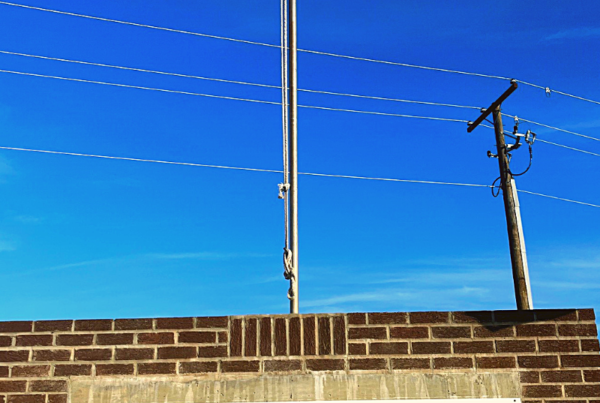No industry is more important than that of the U.S. military and national security apparatus in terms of staying ahead of the curve, and blockchain technology has the power to keep America at the forefront – if both public and private institutions are willing to embrace it.
Blockchain, the technology behind cryptocurrency, is projected to soon surpass the internet in terms of importance and potency. In layman’s terms, blockchain is a collaborative, distributed, meddle-resistant database that every individual or entity on the network can share, but no single individual or entity can dominate.
Thus, blockchain enables a radical transformation in how data is managed and protected, while allowing it to function in a highly challenging, complex climate. It is impossible to alter, tamper with, or erase once the information has been entered on the encrypted chain.

First and foremost, blockchain can make the movement of equipment and information much more effective and practical for military masterminds. The software can trace an item from its place of origin through distribution, wholesale, retailer and eventual deployment, ensuring nothing is lost or damaged no matter how many hands it has passed through.
Because of this, perhaps the most glaring leverage of blockchain is the ability to enable unprecedented trust.
Researchers are subsequently testing the effectiveness of tracking and tracing asset genesis and flow using a “data provenance” technique that would verify data even when connectivity is limited. The information can range from GPS locations to messages, and could potentially expedite emergency help to a specific location, whether a medic or backup force is needed in the middle of a crisis.
If a location or other vital piece of data needs to be changed, the data on the blockchain could rapidly reflect this – giving warfighters and commanders a verifiable, analytic way to confirm the information disseminated. It is virtually impossible for any adversary to alter the information.
Further, the military and intelligence community’s ability to triumph in an increasingly hostile environment hinges on its ability to safeguard cyber-enabled systems, preventing outside intrusions as well as manipulation by malicious parties. Current models of defense will likely become obsolete in twenty years, or even two years from now.
With blockchain technology, data is safeguarded by continuously searching for vulnerabilities and instantly detecting any modifications. The application is not only capable of preventing cyberattacks by fortifying crucial weapons systems, but it can also reject automated swarm schemes. It can also certify orders and handle or harden logistics and supply chains.
This is particularly beneficial to government contractors, as more competence results in significant savings and a stronger bond between the public and private sectors. While weapons platforms and systems have become increasingly sophisticated, supply chains have not kept up, as exemplified by the drastic computer chip shortages of recent months.
Instead of relying on traditional methods, blockchain technology could consolidate the process from raw materials to finished products to retired resources by incorporating everything from reliable device tracking and untampered security to ease of access to trusted information, and the registration and verification of financial exchanges, employee certifications, repairs, and maintenance procedures.
A single minute component of an ordered system, from circuit boards and software components to serial numbers and integrators, could be cataloged on the blockchain, allowing for permanent records to be sent between owners and the easy detection of even the smallest change to the supply. Ultimately, this results in substantial advantages in terms of time, expense, and performance.
A hacker attempting to alter data without authorization is immediately visible to all participants on the chain, making it more secure than traditional data-keeping. Additionally, each person on the sequence knows how the product and part will be shipped, tracked, distributed, and maintained. As it stands, the U.S. government and its private partners aren’t making full use of their goods, which is costing them serious money and putting unnecessary strain on the military and security infrastructure.
As per an assessment by multinational professional services firm Price Waterhouse Coopers (PwC), blockchain could increase industry revenue by up to 4% annually, or US$40bn, while cutting maintenance, repair and overhaul costs by about 5%, or US$3.5bn.
“The technology holds just as much promise in applications for defense manufacturing and operations,” the 2020 analysis continues. “In fact, the complexity of U.S. defense contracting and operations, and the massive size of defense budgets, suggests that the financial gains could be even greater — not to mention the potential increase in national security it can bring.”
Using blockchains, users can also implement smart contracts – pre-existing conditions that automate a particular process. As an example, companies could automate accounts payable using blockchain-enabled smart contracts. When a company orders a product, everyone on the chain is informed at each step: when the order is placed, shipped, delivered, and accepted. The blockchain could then issue a payment, which would again be communicated to all relevant parties at each stage of the encrypted transaction.
“Everyone has access to the same permissioned information, and they can trust that the information is current and correct. In that way, the technology can address a range of manufacturing pain points, including by helping manufacturers detect counterfeits, increasing visibility throughout the supplier network (all tiers) and proactively identifying parts shortages to reduce manufacturing problems, inefficiencies and unnecessary costs,” the report continues. “Blockchain can even track the name and certification level of the technician performing a specific repair.”
Besides enhancing data confidence and availability, blockchain can also improve data management. In the U.S., different agencies can use the technology to make sure it is attainable across the various components of government. Blockchain technology could also make it easier and more attractive for agencies to share information readily.
There are also many uses for blockchain in the battlefield. The troops can expect encrypted, tamper-proof connectivity with air and drone strike controllers thousands of miles away, avoiding any potential repercussions of compromised systems. Blockchain’s decentralized nature also makes information and assets less vulnerable to centralized breaches or fraudulent orders. Those downrange are thus assured that the items they receive meet the necessary standards and have not been manipulated or spied on.
However, if the U.S. government continues to turn something of a blind eye to emerging technology, our security interests will be jeopardized.
Most Bitcoin mining is currently being done in countries hostile to the United States, with considerable attention being paid to military efficacy. According to CNBC, most mining occurs in China, followed by Russia, Kazakhstan, Malaysia, then Iran.
For one, a 2018 article in the People’s Liberation Army (PLA) journal entitled the China Military Network Defense Department Network urged Beijing to do even more in the blockchain space to get the upper hand in the administration of funds for intelligence operations and the shielding of personnel and weapons information. The CCP started bolstering its military logistics organization on blockchain dating back to 2016.
Moreover, this technological shift is viewed positively by Russia as well. The Russian Ministry of Defense opened a laboratory in 2018 to investigate cyber threats, with a primary focus on identifying and blocking attacks on its defense infrastructure. Additionally, the Ministry announced that it will use the technology to share knowledge among army units. Moscow declared that “the internet belongs to the Americans, but the blockchain is ours.”
It’s unclear how Tehran is utilizing the technology, but it’s been rumored for years that the Iranian Revolutionary Guard Corps (IRGC) has been at the forefront of Iran’s bitcoin mining enterprise.
In recent years, the U.S. has dabbled in the technology, which is increasingly seen as a symbol of military superiority. Congress’ 2018 National Security Doctrine Act cited blockchain as a particular area of interest. In the same year, the U.S. Naval Aviation Command unveiled a partnership with Indiana company ITAMCO to better the aviation industry by adopting blockchain to track spare parts, and NATO listed blockchain as one of its contemporary future solutions.
Two years prior to that, the Department of Advanced Research Projects (DARPA) began probing blockchain as a means of data protection specifically for codes on launching nuclear-headed intercontinental ballistic missiles. Both the Treasury Department and the Army have also reportedly begun to experiment with blockchain technologies for tracking devices and identifying antiquated or underused technology; and the Department of Defense is exploring its use for battlefield 3D printing to achieve faster and more secure communications.
“Our primary focus on this effort is to allow the warfighters to trust their information better … really give them a mathematical, verifiable way of vetting their data from sensor to shooter, from the producer to consumer,” stated Humza Shahid, a computer engineer with the Army’s Command, Control, Communications, Computers, Cyber, Intelligence, Surveillance and Reconnaissance (C5ISR) Center, which is part of Army Future Command’s Combat Capabilities Development Command, last year.
Despite that, many of these initiatives remain in rudimentary stages. If America and its allies are serious about remaining at the forefront – and protecting sensitive assets, as well as securing the interests and lives of their citizens – now is the time to act instead of waiting for a crisis that could impede non-blockchain defended mechanisms.






